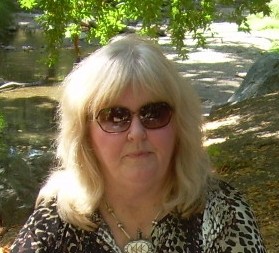 Fellow member of Women Writing the West and Past-President (2015), Anne Schroeder writes memoir and historical fiction set in the West. She has won awards for her short stories published in print and on-line markets. She and her husband, along with their new Lab puppy, live in Southern Oregon where they explore old ruins and out-of-the-way places. Her new release, Maria Ines, is a novel about an Indian girl who grows up under Padre Junipero’s cross and endures life under the Spanish, Mexican and Yanqui conquest of California. You can learn more about Anne at http://www.anneschroederauthor.com and read her blog at http://anneschroederauthor.blogspot.com
Fellow member of Women Writing the West and Past-President (2015), Anne Schroeder writes memoir and historical fiction set in the West. She has won awards for her short stories published in print and on-line markets. She and her husband, along with their new Lab puppy, live in Southern Oregon where they explore old ruins and out-of-the-way places. Her new release, Maria Ines, is a novel about an Indian girl who grows up under Padre Junipero’s cross and endures life under the Spanish, Mexican and Yanqui conquest of California. You can learn more about Anne at http://www.anneschroederauthor.com and read her blog at http://anneschroederauthor.blogspot.com
Anne has very kindly agreed to give away one copy of Maria Inés to one reader who leaves a comment. And the winner is Barb Froman. My thanks to everyone who left a comment.
If you’re like me, reading and writing about the historical West anchors us in a world that feels increasingly adrift. (The past fits neatly with my “earth person” persona, as I embrace home and hearth.) The “everywoman” character leads us into the story and we explore a world that feels familiar. It’s easy to love a character when we identify with her wants, her needs and her pain.
Maria Inés is the protagonist in my historical fiction novel of the same name. She’s on a hero’s journey to find her son who was taken from her as a child, and to find missing parts of herself. She is patient and accepting, and relies on her faith in God. Like all great historical characters, she is a “fly on the wall” for the events and times that follow the Spanish, Mexican and Yanqui conquests of California, an era that is rich in story and color. A Mission Indian, a neophyte, she has been baptized by the padres who travel with Father Junípero Serra. She and her People provide hides, food and gold for the gente de razón literally “people of reason,” the high-borns in California and Spain.
I began writing this novel after I heard someone say that they would never visit a California Mission because the Catholics killed off all the Indians through genocide; that the Missions were an evil place. My research and my college studies showed me that the truth was a lot more complicated. Maria Ines seemed to agree because she led me (and is still leading me) through nuances that include her intense love for the Catholic Church in spite of how it overturned her world. Interestingly, by the time the Yanquis arrived, the gente de razón and the Church were split in their loyalties, some siding with Mexico, others with Spain, and a civil war was in the works.
The Salinans fared well under the Mission system, if one doesn’t consider the downside of cultural eradication. But the quiet world of the Missions ended in 1834, when the Mexican government, who had won its freedom from Spain, instituted a policy of secularization that set the Salinans free—of their occupations, food and religious strictures. With their native plants destroyed by tens of thousands of Mission cattle and horses, and little memory of the old ways, the people were depleted in spirit and health. Thus begins the Time of the Troubles of which I write. By then their numbers had been decimated by white men’s diseases, the big one being syphilis, introduced by the soldiers.
Maria Inés is a composite from stories shared by women of the Salinan tribe in California’s Central Coast. I read their stories, walked their beaches and rivers, camped in their great-grandmothers’ rancherías, visited their mortars and pounded acorns in the same worn stone pockets. I made adobe bricks to repair the walls of Mission San Miguel after the 2002 earthquake. I listened to their traditional music, sifted through chert piles for the bone fragments and broken sea shells they left behind. I stood beneath a huge valley oak and heard Maria Inés calling to me.
These facts and details provided a boundary for my characters to move within. My project began with a timeline drawn on butcher paper, stretched across a wall of my writing room. On this paper I included relevant scraps of info that I found in period biographies and non-fiction books. At present I have about 60 books, but I’m always adding to my collection. Many of the books are about the Plains Indians. It’s harder to find information about the California tribes, I suspect, because male writers and readers are intrigued by the guns and battles between the tribes and the US Army. Not much of that in California. The takeover by America was pretty much an insurgency of 49ers who poured into the state and overran the native Californios. Many of those who prospered married their daughters off to enterprising Yanquis.
Many of the Salinan married Mexican or Spanish soldiers and most of their descendents still live within the original tribal boundaries. The language root of the Salinan is the same as that of the Aztecan, and unique to only these two groups. One theory is that when the huge tribe migrated across the Bering Strait from Asia, the weak and the unwarlike were left behind in California.
I met with several Salinan women elders, heard some of their stories and read the books that were available about their history. Maria Inés’ story continues to guide me. I’m working with one of the Salinan women who is a direct descendant of Tiburcio Vasquez, an infamous bandido and gente de razon who terrorized early Yanqui arrivals. The result will be The Caballero’s Son, a story of Maria Inés’ lost son.
Cholama Moon, (Oak Tree Books) follows Maria Ines’s journey. Five Star Publishing has made Maria Inés available in hardcover for libraries and bookstores, and Kindle. If you feel so inclined, ask your library to order a copy so that readers can discover a strong California Indian woman. Both of these are available on Amazon and Kindle.
 Maria Inés is available at
Maria Inés is available at
Five Star: http://goo.gl/thHPoY
AND Amazon: https://www.amazon.com/Maria-Inés-Anne-Schroeder-ebook/dp/B01M7O422I/
Here’s an Excerpt:
Alta California
September, 1818
Chapter One
The fury of the storm seemed to be a warning. The few who still called themselves the People of the Oaks whispered that the flooding was the gods’ anger because they had left their villages and their traditional ways to dwell among the padres at Mission San Miguel Arcángel. But others argued not. For them the rain was a blessing from the true God.
“Let the rains come,” a young woman prayed as she lay waiting for her next birthing pain. “Let us be safe this night.” She was a neophyte, a baptized Indian with a name given to her by the padres and she felt afraid in this new place. But no travelers would arrive seeking hospitality in this weather. Tonight El Camino Real was flooded, the thin wagon track that followed the rivers and valleys from the border of New Spain, north to the Missions of Alta California. “Let the rains come,” she repeated. “Let our fields and our hearts be renewed.”
Her heart was one with the forces raging outside her walls, ancient winds whipping through the olive grove, ripping off branches and pitching them into the north wall of the dormitory. The sound of singers and cantors in the nearby church were muted as whorls of rain lashed the clay-tiled roofs, windows, and rough-hewn doors.
Alfonsa lay inside the adobe room assigned to her husband, Domingo. Restlessly, she stirred in her birthing bed, feeling its sturdy willow frame flex beneath her. A fragrant layer of pine needles sent out a sweet fragrance, sap freed by a layer of heated rocks in the trench beneath her. She breathed deeply and her mind saw the forest where, a few days earlier, she had walked from sunrise to sunset to gather pine boughs. Domingo had built the bed in the way of her ancestors to please her, a deep rectangular trench dug into in the hard-packed adobe floor holding five rocks still hot from the fire. His mother bound the frame with woven tule grass to protect the skin from the heat. Alfonsa now rested safely above the half-buried stones and waited.
“It is good, ’mingo,” she whispered, and her heart swelled with gratitude. She longed to tell him this, but he was not present. His mother had chased him from the room because the old taboos did not allow him to take part in the birth. The two were both at evening service, along with every other neophyte, and she was alone.
A basket of pine nuts lay nearby, a gift he had brought so she would have strength for her ordeal. She glanced at the basket, but her body was filled with anticipation, not hunger—a thing her husband would not understand because his belly was never full, even after he had taken his meal. Alone but unafraid, she bit down on an olive twig to blunt her moan from the world outside. “The rain is God’s gift,” she whispered through cracked lips. “Our prayers are heard.”
Another pain engulfed her. She shut her eyes, bit into the twig, and tried to hold onto yesterday’s memory when Padre Juan Martin had stood in the courtyard, his hands raised to the sky as a warm breeze wafted his robe like the wings of a dove. Strong and fervent, his voice swelled to the cloudless sky as he led his people in prayer for rain. Rain so that there would be more wheat in the fields and vegetables in the gardens. Food for the escolte, the Spanish soldiers protecting the Mission. Food for the padres and their guests. Grain to trade to the other Missions and to send to the governor for taxes. And if there was any left, food for the neophytes, for her and her baby soon to be born.
The summer heat had been intense, the rain sparse, but the Spanish Governor de Solá had levied extra taxes in the form of wine and cattle hides. Many workers died in the latest round of hunger and typhoid, leaving fewer to gather the crops. She did not complain like some of the others who groused under their breath about the six hours of labor required of them—even though the padres worked as hard as any of them—but drought made things harder. Her belly, big with baby, made drawing water difficult; carrying the burden basket pulled down her shoulders and strained her back with the pressure of the strap. This is why she knew God had sent the rain for her, and just in time.
















Powerful stuff. Interesting, informative and with a female protagonist!
I love reading history and like you said this particular history is underreported.
LikeLike
I’ve read but little about this time and place in history, but I am a fan of historical fiction and this small bit has intrigued me.
LikeLike
I was a reader for Anne’s Cholama Moon and the early pages of Maria…happy to see it come to fruition and I look forward to a good read!
LikeLike
Thank you, ladies for your comments. I. too am surprised at how little attention is paid to the California Indians. It’s a wonderfully wide-open field. Thank you for your interest.
LikeLiked by 1 person
I’m so glad you shared that a single statement about the Catholic church and genocide was the inspiration to dig deeper and find the complex truth. It reminds us to always be listening and questioning.
Thanks for sharing a bit of your story. I’m looking forward to an insightful, revealing journey. Thanks for doing all the work.
LikeLike
An amazing post, Anne and Andi! I read each word as I learned the background for Maria Ines, how much of the research was hands-on, and that there are a few Salinan who feel their story needs to be told. Maria Ines is on my TBR list!
LikeLike
Growing up in California, I studied history of the state, but it didn’t say much about the native Californians. This looks like a wonderful story.
LikeLike
Very intriguing. It’s good to know there are better source materials for this time in California than what I found 20 years ago when trying to research Californian history. I had to believe there was more to the Mission and hidalgo period than a Zorro figure who’d been played up in film and TV. The simple lives of native Americans of California haven’t been well documented. I would love to learn more about this period. Kudos to the author for her excellent research.
LikeLike
Barb, inspiration is where we find it. And a writ,it”d job is to stay present tpoddibilitirs. Thank you for visiting.
LikeLike
Alice, I apologize for answering so randomly.. My power has been off for three days and I”m reduced to a Tablet and a wrong password. Thank you for visiting.
LikeLike
Thank you Ilona. I think the California history needs to be told. Do you have a story in you? Thanks for taking time to visit. If you request a
That your library oeder a copy then others can share the journey.
LikeLike
Hebbyroman, I found many of my best soiuce books at Mission and museum bookstores. I have requested that the State library stock copies while it is available. I included a bibliography in the back if you’re interested
LikeLike
Hello Anne, great excerpt! I believe that the American history we are taught in school is very Anglo-centered, focusing on what happened in the east starting with the Pilgrims. As an adult I’ve been fascinated to learn there was much interaction going on in North America we don’t hear about, especially in California and Florida. Good luck with your writing endeavors!
LikeLike
I agree, Patti. In high school, thought the “Big Four” built California. Later I realized they profited from the labor of Chinese, Irish, Native Indians and farmers while they lived a favored lifestyle and had their photos taken. When you think about it, the missions were being built while the colonies were fighting for their independence. Wow.
LikeLike
Very intriguing, well-written and gracefully spiced with your research. I look forward to reading this!
LikeLike
Thank you, Kelly.
LikeLike